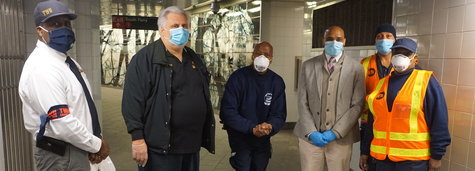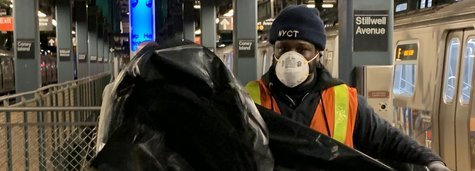Today 4/12 Marks 90 Years Since the Union Began
On April 12, 1934, seven men met in a Columbus Circle cafeteria after a hard night’s work on the IRT to find a way to fight the transit companies which had trampled workers’ rights into bitter dust. They knew that in past years – 1905, 1910, 1916, strikes had failed to create a union.
In 1916, the IRT actually spent $3,500,000 to hire scabs and thugs, and planted dynamite at the subway station at 96th Street and Broadway, framing several strike leaders. In 1918, scabs were assigned to drive a train on what is now the Franklin Street shuttle on Malbone Street. The train derailed, killing 100 passengers. To wipe away the memory, the City renamed the street Empire Boulevard. Strikes conducted in 1919 and 1926, failed as well, with hundreds fired.
The night before the Columbus Circle meeting, where Mike Quill and six other workers met secretly on April 12, 1934 to organize transit workers, the 148th Street Shop had been promised that there would be no more layoffs and that a 44-hour week would be introduced with the same pay previously earned for the 50-hour week. But then management reneged on its offer and layoffs continued. The work week wasn’t changed.
As John O’Connell, who worked closely with the Union’s first international president, Mike Quill, recounted in his unpublished history of the union, “it was time for action… Each of the seven men pledged to contact four or five other workers who could be trusted. They planned to concentrate organization efforts in the electric power stations and the barns and shops where many workers were gathered together by the conditions of the job.
 “They met in secret to confront terror and intimidation. They met in restaurants, on street corners, and once in Central Park under an overpass. The IRT “beakies” as the bosses’ spies were called, plagued and hounded them.”
“They met in secret to confront terror and intimidation. They met in restaurants, on street corners, and once in Central Park under an overpass. The IRT “beakies” as the bosses’ spies were called, plagued and hounded them.”
By May, the word was out in 2,000 leaflets: “Join the Transport Workers Union, Independent!"
Mike Quill recalled: “I worked as a ticket agent in the subways for about eight years, 12 hours a night, seven nights a week. The motormen, conductors, and guards worked 16 hours a day to get ten hours’ pay. Sometimes they sat on the bench waiting for an assignment and returned home with nothing.”
In 1935, with organizing efforts yielding results, Quill wrote to the Interborough Company of New York. “Greetings,” he wrote. “We have news for you. We are building an independent union.”
To the men he organized, Quill had something else to say: “Most of my life I’ve been called a lunatic, because I believe that I am my brother’s keeper. This is my religion.”
The turning point for the TWU came in January of 1937 when the BMT fired three power plant engineers in January. 498 of the plant’s 505 workers pinned TWU buttons on their work shirts, closed the doors, and sat-in for 14 hours. Word spread quickly throughout the system. Workers from all over converged on the Kent Avenue plant, picketing and organizing food brigades for the sit-in strikers. They prevented company police and strike-breakers from breaking through the barricaded doors. The TWU issued an ultimatum to the BMT: Reinstate the fired workers or we will shut off the power, affecting 2,400,000 BMT riders.
The company caved in – and the rest is history. The TWU organized the entire transit system, and by the end of 1937, it had become an International Union affiliated with the Congress of Industrial Organizations, 30,000 members strong in New York City. The half-century struggle to unionize the New York transit system had ended in near total victory. The TWU’s trajectory led up from there, branching out throughout the United States, today claiming some 90 Local unions in surface transit, rail, buses and airlines.
Photo above: (Left to Right) John Santo, Mike Quill, Douglas McMahon, Austin Hogan, Harry Sacher, and Maurice Forge.














